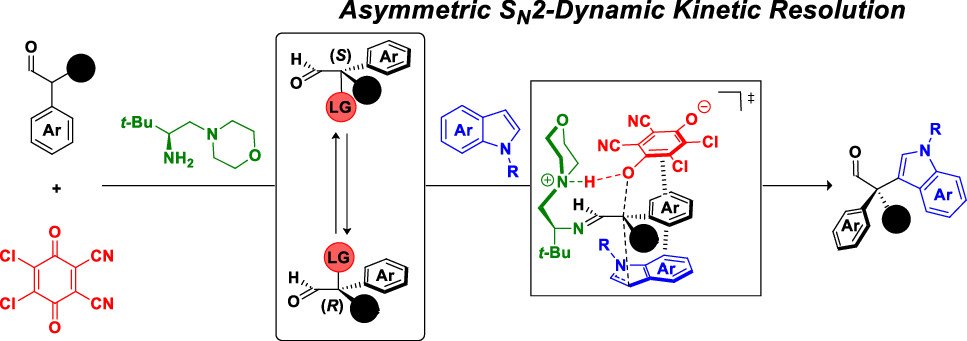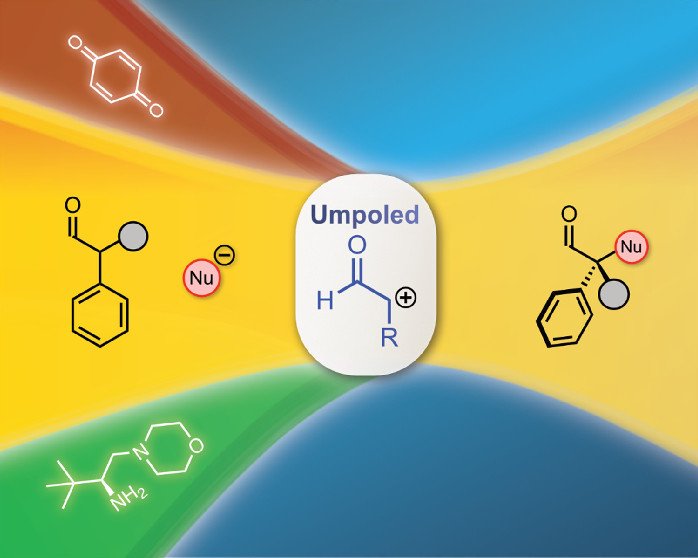Oxidative Chemistry
This series of projects was driven by serendipity (treating α-branched aldehydes with a Ag(I) oxidant and a primary amine catalyst in the presence of a carboxylic acid yielded an α-esterified product), which unveiled entirely new domains for rationalizing aminocatalytic reactions and opened up new avenues for asymmetrically installing simple polar nucleophiles at the α-position of aldehydes. Evidently, this is an umpolung process. Prior to this, enamine catalysis in combination with umpoled electrophilic heteroatom reagents, had been used in several successful methodologies for the asymmetric formation of carbon–heteroatom bonds. In addition, the organo-SOMO concept had been developed for the functionalization of the α-position with nucleophilic partners. However, the discovered approach exhibited deviations from typical SOMO catalysis indicating a new class of reactions─organocatalyzed cross-nucleophile coupling (organo-CNC) reactions: (1) the product was formed exclusively using primary amine catalysts, which differs from the iconic radical cation intermediate of secondary amines, and (2) only one component of the coupling underwent oxidation. Mechanistic studies and computational studies in collaboration with the Houk lab have revealed key aspects of the reaction mechanism. Namely, these reactions proceed through a stereomutative SN2-DKR process after the oxidation step and are governed by the chiral aminocatalyst.
Organo-CNC reactions have proven to be general for the coupling of α-branched aldehydes with a variety of nucleophiles to form congested C–O, C–C, C–N, and C–S bonds employing carboxylic acids, amino acids, peptides, alcohols, hydroxylamines, oximes, hydroperoxides, indoles, amines, and thiols as coupling partners, respectively. These technologies have been extended to peptidic bioconjugations bearing bio-orthogonal linker molecules. The extension of the methodology to the formation of quaternary carbon stereocenters while simultaneously developing a completely metal-free method proved to be a productive endeavour. The resulting non-epimerizable stereocenter demonstrates high optical fidelity and provides a significant advancement in many applications that suffer from racemization, such as in vivo studies.
These seminal publications have shown broad functional group tolerance and wide substrate scopes. However, highly enantioselective examples have largely been limited to α-methyl branched aldehydes. Furthermore, asymmetric CNC reactions based on other carbonyl substrates (e.g., ketones, amides) and strongly basic nucleophiles have largely remained unexplored. Further studies are anticipated to address these limitations through the development of new catalyst and oxidant systems. Addressing these challenges will be critical to spur the development and foster the maturation of organo-CNC reactions into a general modular reaction paradigm.
Selected Articles on Oxidative Chemistry
Enantioselective Oxidative Coupling of Carboxylic Acids to α-Branched Aldehydes
J. Am. Chem. Soc. 2018, 140, 40, 12687–12690
An Asymmetric SN2 Dynamic Kinetic Resolution
J. Am. Chem. Soc. 2021, 143, 19, 7509–7520
Organocatalyzed Cross-Nucleophile Couplings: Umpolung of Catalytic Enamines
Acc. Chem. Res. 2022, 55, 12, 1703–1717



